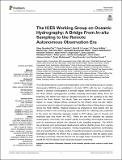Por favor, use este identificador para citar o enlazar a este item:
http://hdl.handle.net/10261/319744COMPARTIR / EXPORTAR:
 SHARE SHARE
 CORE
BASE CORE
BASE
|
|
| Visualizar otros formatos: MARC | Dublin Core | RDF | ORE | MODS | METS | DIDL | DATACITE | |

| Título: | The ICES Working Group on Oceanic Hydrography: A bridge from in-situ sampling to the remote autonomous observation era. |
Autor: | González-Pola, César; Fratantoni, Paula; Larsen, K.M.H.; Holliday, N.P.; Dye, S.; Mork, K.A.; Beszczynska-Möller, A.; Valdimarsson, H.; Trofimov, A.; Parner, H.; Klein, H.; Cisewski, Boris; Fontán, A.; Lyons, Kieran; Kolodziejczyk, N.; Graña, Rocío; Linders, J.; Wodzinowski, T.; Goszczko, I.; Cusack, Caroline | Palabras clave: | Ocean climate Centro Oceanográfico de Gijón Medio Marino y Protección Ambiental hydrography timeseries in-situ sampling periodical report science to policy North Atlantic |
Fecha de publicación: | 2019 | Editor: | Frontiers Media | Resumen: | The ICES (International Council for the Exploration of the Sea) Working Group on Oceanic Hydrography (WGOH) was established in the late 1970’s with the aim of gathering experts in physical oceanography to provide regular science-based assessments of the North Atlantic hydrographical condition (basically termohaline fields). From the beginning, the WGOH has relied on repeated long-term in-situ sampling at key sites around the North Atlantic, the Nordic Seas and adjacent shelf seas. An annual Report on Ocean Climate (IROC), produced by the WGOH since the late 1990’s, summarizes trends in regional hydrography and identifies patterns linking these changes across the North Atlantic. Regional analyses are prepared by local experts who are directly involved in the monitoring programs responsible for collecting data presented in the report. An interactive webpage created in 2013 allows users to browse and download data that inform the IROC. Within the last two decades the physical oceanography community has evolved quickly incorporating technological advances such as autonomous devices into classical in-situ sampling programs. The WGOH has embraced such technological developments without diverting focus from ongoing in-situ long-term monitoring programs. Having longstanding experience synthesizing data and expertise from a large number of operational programs spanning an extensive international footprint, the WGOH has a unique perspective to offer the global ocean observing community. Here we discuss how we might foster connections with ICES to benefit the GOOS (Global Ocean Observing System) community. | URI: | http://hdl.handle.net/10261/319744 | DOI: | 10.3389/fmars.2019.00103 | ISSN: | 2296-7745 |
| Aparece en las colecciones: | (IEO) Artículos |
Ficheros en este ítem:
| Fichero | Descripción | Tamaño | Formato | |
|---|---|---|---|---|
| 25439.pdf | 842,5 kB | Adobe PDF |  Visualizar/Abrir |
CORE Recommender
SCOPUSTM
Citations
3
checked on 28-abr-2024
WEB OF SCIENCETM
Citations
3
checked on 22-feb-2024
Page view(s)
32
checked on 15-may-2024
Download(s)
24
checked on 15-may-2024
Google ScholarTM
Check
Altmetric
Altmetric
Este item está licenciado bajo una Licencia Creative Commons

